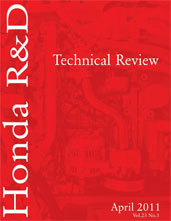1998-02-23
Development of a Lubrication Model for the CMC Scotch Yoke Mechanism 980119
This paper presents some of the modelling and experimental work being carried out at the University of Melbourne, in collaboration with CMC Research, on their new Scotch yoke engine concept. It begins with an overview of the engine, its compactness and friction advantages. The development of a one dimensional ‘squeeze film’ model is outlined and some simulation results are presented for both a motored and fired engine. A novel feature of the model is the introduction of an ‘un-filled factor’ to account for the dynamics of the oil film volume particular to this type of linear bearing. Experimental results are presented to highlight the important features and serve as a means of validating the model predictions. Comparisons show that the squeeze model correlates reasonably well with the experimental data and it is concluded that the current, flat, bearing design works by a predominantly squeeze film mechanism. To permit the investigation of alternative geometries, which may enable hydrodynamic lubrication, a multi-dimensional model is being developed. A brief description of the models features is provided, along with the proposed outcomes from its application.
SAE MOBILUS
Subscribers can view annotate, and download all of SAE's content. Learn More »
TECHNICAL PAPER
The Collins Scotch Yoke Engine as a Compact Alternative - A Theoretical Comparison of Features of Scotch Yoke and Conventional Engines
950091
TECHNICAL PAPER
Conditions for Significant Efficiency Improvement in the Product Development Chain by the Application of Integrated Virtual Engineering
2007-01-0951

BOOK
Honda R&D Technical Review: April 2011
